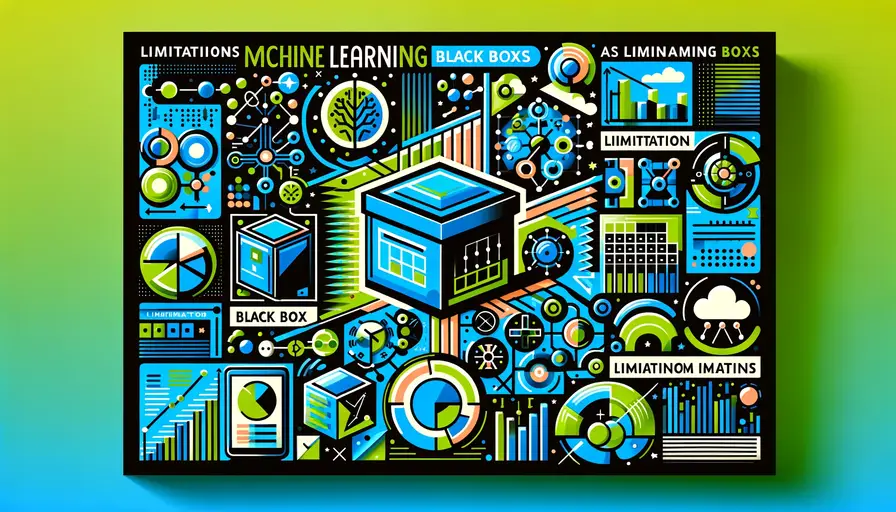
Limitations of Machine Learning Models as Black Boxes

Black Box Models
Machine learning models, especially those involving deep learning, often function as black boxes. This means their internal workings are not easily interpretable by humans, even though they can make highly accurate predictions. Understanding the limitations and constraints of these black box models is crucial for their effective deployment in various domains.
What are Black Box Models?
Black Box Models refer to machine learning algorithms whose internal logic is hidden from the user. These models take inputs and provide outputs without providing insight into how decisions are made. Common examples include deep neural networks and ensemble methods like random forests.
Importance of Transparency
Transparency in machine learning models is important for debugging, trust, and compliance. Without understanding how a model arrives at its predictions, it's challenging to trust its results, especially in critical applications like healthcare, finance, and legal systems.
Example: Black Box Model in Python
Here’s an example of training a deep learning model, which is often considered a black box, using the Keras library in Python:
 Moving Away from Black Box ML: The Importance of Explanation
Moving Away from Black Box ML: The Importance of Explanationimport tensorflow as tf
from tensorflow.keras.models import Sequential
from tensorflow.keras.layers import Dense
# Load dataset
from sklearn.datasets import load_breast_cancer
data = load_breast_cancer()
X, y = data.data, data.target
# Split data into training and testing sets
from sklearn.model_selection import train_test_split
X_train, X_test, y_train, y_test = train_test_split(X, y, test_size=0.2, random_state=42)
# Define the model
model = Sequential([
Dense(30, activation='relu', input_shape=(X_train.shape[1],)),
Dense(15, activation='relu'),
Dense(1, activation='sigmoid')
])
# Compile the model
model.compile(optimizer='adam', loss='binary_crossentropy', metrics=['accuracy'])
# Train the model
model.fit(X_train, y_train, epochs=20, batch_size=10)
# Evaluate the model
loss, accuracy = model.evaluate(X_test, y_test)
print(f'Test accuracy: {accuracy}')Lack of Interpretability
One of the major constraints of black box models is their lack of interpretability. This limitation makes it difficult to understand the reasoning behind the model's decisions, which can be a significant drawback in many applications.
The Challenge of Interpretability
Interpretability refers to the ability to explain how a model arrives at a particular decision. For black box models, the complex transformations and layers make it nearly impossible to trace the decision-making process. This lack of transparency can lead to issues in trust and accountability.
Impact on Trust and Accountability
Without interpretability, stakeholders may find it difficult to trust the model's predictions, especially in high-stakes situations. This lack of trust can hinder the adoption of machine learning models in sectors that require stringent regulatory compliance and ethical standards.
Example: Interpretability Challenge
Consider a deep learning model used for credit scoring. While it may achieve high accuracy, its lack of interpretability could lead to questioning by regulatory bodies. This challenge is often addressed by using interpretable models or techniques such as LIME (Local Interpretable Model-agnostic Explanations):
 Can Machine Learning Models Achieve Fairness?
Can Machine Learning Models Achieve Fairness?import lime
import lime.lime_tabular
# Create a LIME explainer
explainer = lime.lime_tabular.LimeTabularExplainer(X_train, feature_names=data.feature_names, class_names=['No', 'Yes'], discretize_continuous=True)
# Explain a prediction
exp = explainer.explain_instance(X_test[0], model.predict, num_features=5)
exp.show_in_notebook(show_table=True)Susceptibility to Bias
Black box models can inadvertently learn and propagate biases present in the training data. This susceptibility to bias is a significant limitation that can lead to unfair or discriminatory outcomes.
Understanding Model Bias
Model Bias occurs when a machine learning model consistently makes errors in one particular direction. This bias can stem from imbalanced training data, where certain groups are underrepresented, leading the model to perform poorly on those groups.
Consequences of Bias
Bias in machine learning models can have serious consequences, particularly in areas such as hiring, lending, and criminal justice. Biased models can reinforce existing inequalities and lead to unfair treatment of certain groups.
Example: Detecting Bias in Models
Here’s an example of detecting bias in a machine learning model using fairness metrics:
 Improving Data Privacy: NLP and ML for Breach Identification
Improving Data Privacy: NLP and ML for Breach Identificationfrom sklearn.metrics import confusion_matrix, accuracy_score
# Predict on test data
y_pred = model.predict_classes(X_test)
# Calculate confusion matrix
cm = confusion_matrix(y_test, y_pred)
print(cm)
# Calculate fairness metrics
true_negative, false_positive, false_negative, true_positive = cm.ravel()
accuracy = accuracy_score(y_test, y_pred)
print(f'Accuracy: {accuracy}')Overfitting and Generalization
Black box models, especially complex ones like deep neural networks, are prone to overfitting. This means they perform exceptionally well on training data but poorly on unseen data, limiting their generalization capabilities.
What is Overfitting?
Overfitting occurs when a model learns the noise and details in the training data to an extent that it negatively impacts its performance on new data. An overfitted model has low bias but high variance.
Mitigating Overfitting
Several techniques can be used to mitigate overfitting, including cross-validation, regularization, and pruning. These techniques help ensure that the model generalizes well to new, unseen data.
Example: Regularization in Deep Learning
Here’s an example of using dropout regularization to prevent overfitting in a deep learning model:
 Improving Machine Learning Data Quality
Improving Machine Learning Data Qualityfrom tensorflow.keras.layers import Dropout
# Define the model with dropout layers
model = Sequential([
Dense(30, activation='relu', input_shape=(X_train.shape[1],)),
Dropout(0.5),
Dense(15, activation='relu'),
Dropout(0.5),
Dense(1, activation='sigmoid')
])
# Compile the model
model.compile(optimizer='adam', loss='binary_crossentropy', metrics=['accuracy'])
# Train the model
model.fit(X_train, y_train, epochs=20, batch_size=10, validation_split=0.2)
# Evaluate the model
loss, accuracy = model.evaluate(X_test, y_test)
print(f'Test accuracy: {accuracy}')High Computational Cost
Training and deploying black box models, particularly deep learning models, require significant computational resources. This high computational cost can be a barrier to their use, especially for smaller organizations.
Resource Requirements
Resource requirements for black box models include powerful GPUs, large amounts of memory, and extensive storage for the large datasets used in training. These requirements can lead to high costs and limit accessibility.
Scalability Challenges
Scalability can be an issue with black box models, as increasing the model complexity to improve performance often leads to exponentially higher computational demands. This makes it challenging to deploy these models at scale.
Example: Distributed Training with TensorFlow
Here’s an example of setting up distributed training to handle the computational demands of training a deep learning model:
 The Impact of Machine Learning on Privacy and Data Security
The Impact of Machine Learning on Privacy and Data Securityimport tensorflow as tf
# Define a strategy for distributed training
strategy = tf.distribute.MirroredStrategy()
# Build and compile the model within the strategy scope
with strategy.scope():
model = Sequential([
Dense(30, activation='relu', input_shape=(X_train.shape[1],)),
Dropout(0.5),
Dense(15, activation='relu'),
Dropout(0.5),
Dense(1, activation='sigmoid')
])
model.compile(optimizer='adam', loss='binary_crossentropy', metrics=['accuracy'])
# Train the model
model.fit(X_train, y_train, epochs=20, batch_size=64, validation_split=0.2)
# Evaluate the model
loss, accuracy = model.evaluate(X_test, y_test)
print(f'Test accuracy: {accuracy}')Data Dependency
Black box models heavily rely on large amounts of high-quality data for training. This dependency on data can be a constraint, as acquiring and processing sufficient data can be challenging.
Data Quality and Quantity
Data quality and quantity are critical factors in the performance of black box models. Poor quality data or insufficient data can lead to inaccurate models that do not generalize well to new data.
Challenges in Data Acquisition
Acquiring high-quality data can be time-consuming and expensive. Additionally, data privacy and security concerns can limit access to valuable datasets, further complicating the training process.
Example: Data Augmentation in Image Processing
Here’s an example of using data augmentation to increase the size and variability of a dataset in image processing:
 Privacy in Machine Learning with Adversarial Regularization
Privacy in Machine Learning with Adversarial Regularizationfrom tensorflow.keras.preprocessing.image import ImageDataGenerator
# Define the data augmentation generator
datagen = ImageDataGenerator(
rotation_range=40,
width_shift_range=0.2,
height_shift_range=0.2,
shear_range=0.2,
zoom_range=0.2,
horizontal_flip=True,
fill_mode='nearest'
)
# Load and augment images
image = tf.keras.preprocessing.image.load_img('example.jpg', target_size=(150, 150))
x = tf.keras.preprocessing.image.img_to_array(image)
x = x.reshape((1,) + x.shape)
# Generate augmented images
i = 0
for batch in datagen.flow(x, batch_size=1):
plt.figure(i)
imgplot = plt.imshow(tf.keras.preprocessing.image.array_to_img(batch[0]))
i += 1
if i % 4 == 0:
break
plt.show()Ethical and Legal Concerns
The use of black box models raises significant ethical and legal concerns, particularly around bias, fairness, and accountability. These concerns can limit the deployment of these models in certain sectors.
Bias and Fairness
Bias and fairness in black box models are critical ethical concerns. These models can inadvertently perpetuate biases present in the training data, leading to unfair outcomes. Ensuring fairness requires careful consideration of the data and the model's behavior.
Accountability and Transparency
Without interpretability, it is challenging to hold black box models accountable for their decisions. This lack of transparency can be problematic in applications where accountability is crucial, such as legal decisions or hiring processes.
Example: Bias Mitigation Techniques
Here’s an example of using bias mitigation techniques in Python:
from aif360.algorithms.preprocessing import Reweighing
from aif360.datasets import BinaryLabelDataset
from aif360.metrics import ClassificationMetric
# Load dataset
data = load_breast_cancer()
X, y = data.data, data.target
dataset = BinaryLabelDataset(df=pd.DataFrame(X), label_names=['label'], protected_attribute_names=['attribute'])
# Apply reweighing
RW = Reweighing(unprivileged_groups=unprivileged_groups, privileged_groups=privileged_groups)
dataset_transf = RW.fit_transform(dataset)
# Train model on transformed data
model = LogisticRegression()
model.fit(dataset_transf.features, dataset_transf.labels.ravel())
# Evaluate the model
metric = ClassificationMetric(dataset, dataset_transf, unprivileged_groups=unprivileged_groups, privileged_groups=privileged_groups)
print(metric)Limited Generalization to Unseen Data
Black box models, particularly those with high complexity, can struggle to generalize to new, unseen data. This limitation can result in poor performance when the model encounters data that is different from the training set.
Overfitting vs. Underfitting
Overfitting occurs when a model learns the training data too well, including noise and outliers, leading to poor generalization. Underfitting, on the other hand, occurs when the model is too simple to capture the underlying patterns in the data.
Techniques to Improve Generalization
Several techniques can be used to improve the generalization of black box models, including cross-validation, data augmentation, regularization, and dropout. These techniques help ensure that the model performs well on new data.
Example: Cross-Validation in Model Training
Here’s an example of using cross-validation to improve model generalization in Python:
from sklearn.model_selection import cross_val_score
# Load dataset
data = load_breast_cancer()
X, y = data.data, data.target
# Define the model
model = LogisticRegression()
# Perform cross-validation
scores = cross_val_score(model, X, y, cv=5)
print(f'Cross-validation scores: {scores}')
print(f'Mean score: {scores.mean()}')Difficulty in Debugging and Maintenance
Debugging and maintaining black box models can be challenging due to their complexity and lack of interpretability. This limitation can hinder the deployment and continuous improvement of these models.
Challenges in Debugging
Debugging black box models is difficult because their internal workings are not transparent. Identifying and fixing issues such as data leakage, feature interactions, and hyperparameter tuning becomes more complex.
Maintenance and Updates
Maintaining and updating black box models require significant effort to ensure they continue to perform well over time. This includes monitoring model performance, retraining with new data, and addressing any emerging biases or ethical concerns.
Example: Monitoring Model Performance
Here’s an example of setting up model performance monitoring in Python:
from sklearn.metrics import accuracy_score, precision_score, recall_score
# Load dataset
data = load_breast_cancer()
X, y = data.data, data.target
# Train model
model = LogisticRegression()
model.fit(X, y)
# Monitor performance
def monitor_performance(model, X, y):
y_pred = model.predict(X)
accuracy = accuracy_score(y, y_pred)
precision = precision_score(y, y_pred)
recall = recall_score(y, y_pred)
return accuracy, precision, recall
# Initial performance
initial_performance = monitor_performance(model, X, y)
print(f'Initial performance: {initial_performance}')
# Simulate new data and update model
X_new, y_new = X + np.random.normal(0, 0.1, X.shape), y
model.fit(X_new, y_new)
# Updated performance
updated_performance = monitor_performance(model, X_new, y_new)
print(f'Updated performance: {updated_performance}')Black box models offer powerful capabilities for solving complex problems, but they come with significant constraints and limitations. These include lack of interpretability, susceptibility to bias, overfitting, high computational costs, data dependency, ethical and legal concerns, limited generalization, and difficulty in debugging and maintenance. Addressing these challenges requires a combination of technical strategies, ethical considerations, and ongoing vigilance to ensure that machine learning models are robust, fair, and trustworthy. As the field of machine learning continues to evolve, developing methods to mitigate these constraints will be crucial for the successful deployment of autonomous systems in various domains.
If you want to read more articles similar to Limitations of Machine Learning Models as Black Boxes, you can visit the Data Privacy category.






You Must Read